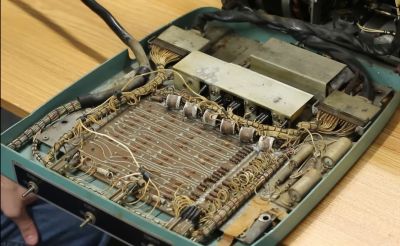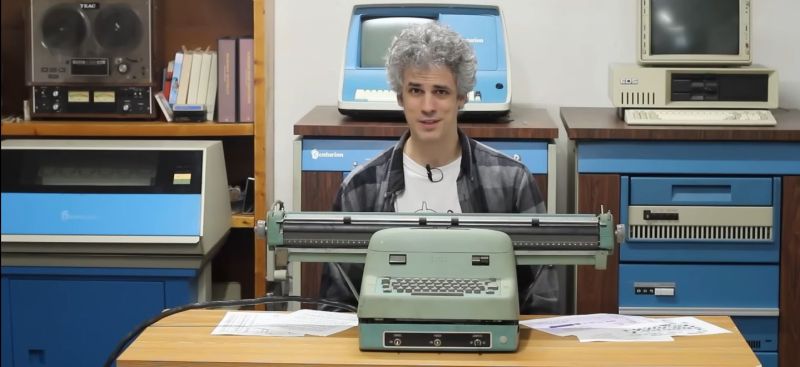The Bendix Corporation’s Bendix G-15 was introduced in 1956 as an affordable system for industrial and scientific markets. As with any computer system, a range of peripheral devices for input and output were available, which includes an electric typewriter. Produced by IBM, this typewriter was heavily modified by Bendix, with the version that [Usagi Electric] got their mittens on being equipped with a gigantic 28″ platen. With just power applied to the machine it will even still work as a regular electric typewriter, but it can do much more.

Most typewriters for the G-15 have a much smaller platen, as can be seen in the brochures for the system. The typewriter is connected together with other peripherals like plotters, card punches and tabulators via a coupler which uses a 5-bit interface. For the encoding on this interface no standard encoding is used, but rather 4 bits are used as data followed by 1 bit to indicate a command. In addition a number of other signal lines are used with the Bendix G-15, which allows control over the punch card reader and run status on the computer from the comfort of the typewriter’s desk.
In addition to the added electronics that communicate with the Bendix G-15, there are also solenoids and sensors which interface with the typewriter’s keyboard. This is what allows for command keys on the typewriter to be recorded separately along with the regular number and letter keys, in addition to the Bendix G-15 using the typewriter to automatically type on the paper. After a good cleaning session the typewriter’s basic functionality is restored, with the hope that once the Bendix G-15 over at the Usagi Farm can power up its DC circuit both will happily chat with each other. Color us excited.

















I helped restore a CDC 1604-A at my university that used one of these. We cornered the market on 2N1711s. I was told it was an IBM “Soroban”. Narrow carriage. First job when we had it running was the “Girl on a Barstool”. Still have it somewhere.
The problem with these type of typewriters (IBM model B and C and the flexowriters all use the same system) is the trigger drum. over the years the rubber gums up or becomes brittle and you see tracks forming on its surface. that means it is going to fail. i temporarily fixed one of mine by milling of a millimeter on a lathe and cover the rubber with the inner tire of a bike. but it would be better to resurface it or peel off the old rubber (measure the diameter first) and try to get a rubber hose to take its place.
Nice article, but I still consider Kristina “The HaD Keeper of the Keebs”!